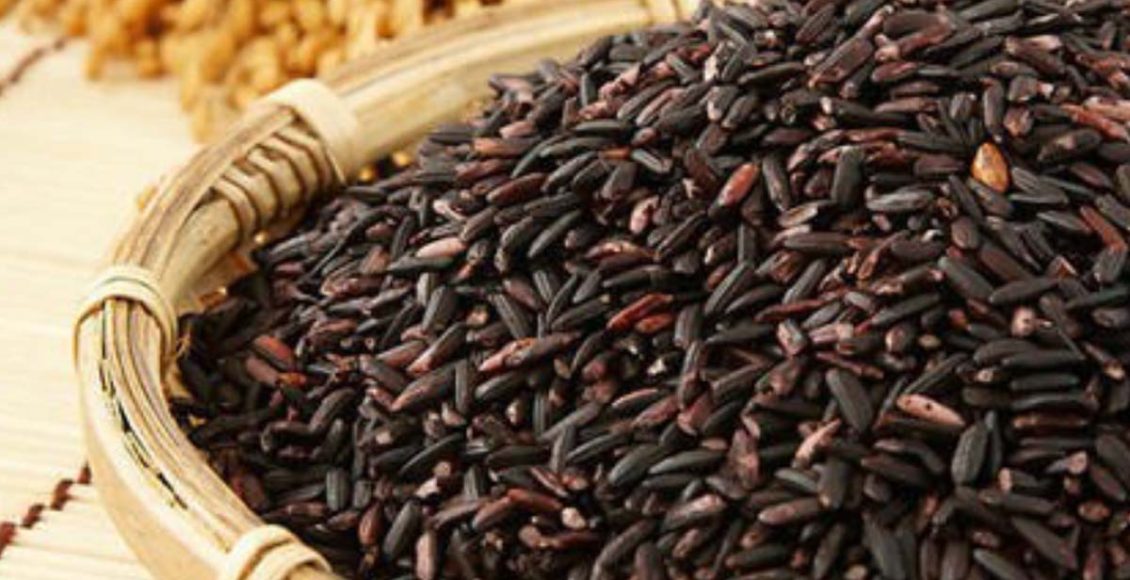
Black Rice – the Super food with potential to revamp our food palette
Black rice (Zizania aquatica) or “forbidden rice” is a rice variety with promising health benefits derived from its rich content of antioxidants (derived from the black colored anthocyanin pigment), iron and vitamin E content. The presence of anthocyanin pigment on the outermost layer of the rice kernel gives its attractive black color. The traits in black rice are caused due to rearrangement of Kala4 gene, which activates the production of anthocyanins. Black rice has higher levels of protein, fiber, vitamin B (thiamin and riboflavin), folic acid and minerals (iron, zinc, calcium, phosphorous and selenium) than that of white rice. Lysine and tryptophan are the major essential amino acids present in black rice. It is a rich source of tocopherols (vitamin E), iron, and antioxidants which helps in improving health and increasing life span. It offers a wide range of health benefits like antioxidant activity, antiinflammatory properties, lipid oxidation, anti-diabetic, anti-ageing and anticancer effects. According to several study findings, black rice helps in management of wide range of diseases including atherosclerosis, diabetes, Alzheimer’s disease, hypertension, high cholesterol levels, arthritis, allergies, aging signs and even cancer (B. Thanuja, R. Parimalavalli; 2018).
| Comparative nutritional profile of different rice varieties in per 100 g serving* | ||||
| Rice Type | Black rice | Red rice | Brown rice | White rice |
| Carbohydrates (g) | 34 ± 0.05 | 23 ± 0.04 | 24 ± 0.07 | 28 ± 0.03 |
| Protein (g) | 8.5 ± 0.5 | 7 ± 0.05 | 7.9 ± 0.07 | 2.7 ± 0.04 |
| Fat (g) | 2 ± 0.06 | 0.8 ± 0.01 | 0.8 ± 0.02 | 0.3 ± 0.01 |
| Fibre (g) | 4.9 ± 0.3 | 2 ± 0.6 | 1.8 ± 0.5 | 0.6 ± 0.1 |
| Iron (mg) | 3.5 ± 0.15 | 5.5 ± 0.14 | 2.2 ± 0.07 | 1.2 ± 0.19 |
| Tocopherol (mg) | 12.54 ± 0.34 | 10.77 ± 0.24 | 2.2 ± 0.76 | 0.1 ± 0.14 |
| Thiamine (mg) | 0.46 ± 0.032 | 0.33 ± 0.15 | 0.54 ± 0.07 | 0.7 ± 0.06 |
| Riboflavin (mg) | 0.403 ± 0.04 | 0.105 ± 0.03 | 0.1 ± 0.2 | 0.03 ± 0.33 |
| Zinc (mg) | 3.16 ± 0.05 | 1.91 ± 0.036 | 1.8 ± 0.05 | 1.41 ± 0.039 |
*Murali RD, Kumar N (2020)
China accounts for 62% of black rice production in the world followed by Sri Lanka, India, Indonesia and Philippines. In India it is grown in Northeastern states like Meghalaya, Assam, Manipur, Mizoram, and some parts of Odisha, West Bengal, and Jharkhand. In Manipur it is commonly known as Chak-hao, as Kalabati in Odisha, and Kavuni rice in Tamil Nadu. It has cultural and traditional significance to the people of Manipur offering aesthetic value and nutraceutical properties. Poreiton chakhao and Chakao amubi are two of the popular variants of the crop cultivated in Manipur. It takes more time to get cooked than normal rice but is preferred as a delicacy among the locals because of its earthy and nutty taste.
Cultivation of black rice is generally organic, requires less labour for ploughing, weeding and management as compared to other rice varieties. Farmers avoid application of chemical fertilizers and farmyard manure in black rice since such applications enhance vegetative growth of the black rice and increases the production of chaffy grains. However, productivity of black rice is lower (~1.3-1.8 t/ha) as compared to hybrid and other traditional rice varieties (~2.0-5.5 t/ha) under normal conditions (Nepolion Borah et al, 2018). Nevertheless, state government’s (particularly Manipur) are vigorously pursuing System of Rice Intensification (SRI) based black rice cultivation for enhancing yield of the crop. The introduction of high yielding varieties has been further promoting black rice as superfood.
Owing to its appealing aroma, nutritional value, and healing properties it is gradually gaining popularity among the farming community. It fetches higher market price compared to traditional ones with the non-organic variant available at Rs. 150-200/kg in domestic markets and Rs. 200 – 250/kg in international countries and the organic variant priced at Rs. 500/kg. However, due to lack of appropriate government support, inadequate systems and marketing channels, the farmers fail to exploit the potential of this “superfood” variant of rice.
In the recent past, success stories have been coming in from Odisha, Uttar Pradesh and Bihar with farmers not only reaping benefits but also popularizing the crop among other farmers. Further, respective state governments are also encouraging cultivation of the crop primarily for export purposes. In Assam the government is promoting large scale cultivation for sale as organic produce at premium prices in overseas markets. Farmers from Chandauli district of UP are gearing up to export black rice to Australia and New Zealand.
With opportunities opening up in pockets, the crop demands for a holistic and integrated approach through development of improved climate resilient, high yielding varieties, infrastructure, market support, financial initiatives and processing linkages to pave the way for promoting black rice cultivation among farmers as a key crop for both domestic and international consumers. Some state universities like Assam Agricultural University are already working on development of high yielding cultivars to improve farmer returns. Black rice germplasms should be brought in as part of all India rice evaluation projects to identify potential as well as to popularize among enterprising farmer. Further, research on developing varieties with better cooking quality will widen the market acceptability of the product. The growing demand of black rice in international markets of US, Australia has the potential to reform the economies of the black rice growing farming communities. Moreover, with the recent Geographical Indication (GI) tag allotment to Chak-Hao, the black rice of Manipur will further contribute to encouraging commercial cultivation and improve market potential of the crop. Likewise, the product will fetch better returns and export earnings by converting black rice cultivation to certified organic farming.
Additionally, the overall nutritional profile of the crop makes it a functional and novel ingredient in food processing. In order to utilize the complete potential of the crop, the food processing industry should include black rice as novel functional food and a healthy alternative to other common foods. Owing to its profile the industry can explore its application in bakery products, extruded products and anthocyanin pigment application. Further, black rice can also be explored as a nutraceutical product offering health benefits as a potential source of dietary antioxidants. The crop demands for encouraging initiatives from the various stakeholders of the industry to exploit the full potential of its benefits.
Author

Connect with Author at: E-mail agribusiness@sathguru.com
 Grow Beyond
Grow Beyond 

